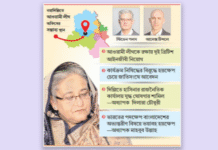Bangladesh’s family Planning program falters while population booms
 Bangladesh burgeoning population is bogging down the overall economy, but there is no sign of any aggressive activism in the family planning sector. From 2011 to 2014, the Total Fertility Rate (TFR) was 2.3 per cent, according to the Bangladesh Demographic and Health Survey (BDHS). In the subsequent years, Bangladesh does not seem to have budged from this standstill. Those involved in the family planning movement say that the country has been stuck in this 2.3 per cent TFR circle the entire decade.
Bangladesh burgeoning population is bogging down the overall economy, but there is no sign of any aggressive activism in the family planning sector. From 2011 to 2014, the Total Fertility Rate (TFR) was 2.3 per cent, according to the Bangladesh Demographic and Health Survey (BDHS). In the subsequent years, Bangladesh does not seem to have budged from this standstill. Those involved in the family planning movement say that the country has been stuck in this 2.3 per cent TFR circle the entire decade.
They say this is the second decade of the country’s TFR inertia. Bangladesh had gone through the first standstill decade from 1991 to 1999. The TFR had been stuck at 3.3 per cent then.
Bangladesh has set the target to bring the TFR down to 1.7 per cent by 2021. However, there is no apparent state-level initiative that is required to emerge from the inertia in the family planning sector to meet this target. The government institutions and the non-government organisations too are quite relaxed, displaying no sense of urgency in this regard.
Dr. Zafrullah Chowdhury, founder and trustee of Gono Shasthaya Kendra sees the need for aggressive activism. Speaking from his experience as a pioneer in the field of public health, Zafrullah Chowdhury says, “We were so aggressive about taking the family planning program ahead after independence of the country. Once we went to Bangabandhu (Bangladesh’s first Prime Minister Sheikh Mujibur Rahman) and said, you have to have a vasectomy. He laughed, ‘why me? I’ve had all my children!’ We said, even so you have to have it. This is a movement and your participation is essential. Even President Abu Sayeed Chowdhury will have to do it, as well as all the ministers of your cabinet.”
Zafrullah Choudhury laughingly recalls, “Bangabandhu may not have had a vasectomy, but we got his support for the movement.”
From 1972 to 1974, the family planning program was implemented as part of the integrated healthcare program. The family planning board and council was placed under the health and family planning ministry. And during that period, birth control pills were taken to the grassroots.
In August 1975 a separate family planning directorate was set up and an independent population and family planning division was started under the same ministry. The TFR was 6.3 per cent at the time and population 76.3 million. The next year, in January 1976, the government declared the rapid population growth rate to be the country’s main problem. In June that year, the national population policy was approved.
Dr. Zafrullah Chowdhury speaks of the vibrant family planning program in the eighties. He says, the high-powered National Council for Population Control (NCPC) was formed under the president’s leadership. Under this council, the National Population Council (NPC) units were established under the zilla parishad chairmen in every district. Similarly, family planning committees were set up under the upazila parishad chairmen in every upazila. An executive committee was formed, headed by the health minister.
The members of parliament were given the responsibility of submitting regular reports on the progress of the family planning program in their respective constituencies. The community leaders and NGOs were brought together. The family planning program became a social movement. By the end of the decade, the TFR was fallen to 3.3 per cent.
Zafrullah Chowdhury advises that the prime minister take initiative to pull the family planning program out of the almost stagnant state that prevails at present. He says, “It will not be possible to emerge from this stagnancy with the present routine performance of the government agencies. Since everything is in the prime minister’s control, she has to take initiative here too. Unfortunately, I haven’t heard the prime minister make any policy statement in this regard in recent times. Perhaps she hasn’t been duly apprised of the matter.”
Going back, among the heads of government, even Ayub Khan in 1959 had spoken about the seriousness of population growth at a seminar of the Family Planning Association of Pakistan (FPAP). The main founder of the organisation was Saeeda Waheed, a member of the All Pakistan Women’s Association. The family planning program began in 1953 under the FPAP banner. In fact, it is Pakistan that was the first Asian country to take up such a program.
Initially FPAP began by spreading awareness about family planning and birth control methodsin urban hospitals and clinics. In 1960 the government took up family planning as a strategy for economic development and in that year the clinic-based family planning service program began.
Presently the population of Pakistan is around 200 million and the TRF there is 3.65 per cent. They plan to bring this down to 2.30 per cent by 2050. The population of India is 1360 million and TRF 2.41 per cent. They plan to bring this down to 1.86 per cent by 2050. But both in Pakistan and India, the obstacle to meeting this target is illiteracy, religious fanaticism and poverty.
The progress of Bangladesh is revealed in various reports. According to the government, the unmet needs for family planning are 12 per cent. Yet another report puts this figure at over 18 per cent. There is demand for the family planning services, but the people are being deprived of this due to structural and institutional weaknesses.
According to the BDHS report, during the 1994 to 2014 period, the number of family welfare assistants visiting house to house fell to 20 per cent from the previous 38 per cent and in this time, less women were aware of the family planning services. The awareness of married women in this regard fell from 47 per cent just to 30 per cent.
The government took up the Health, Nutrition and Population Sector Program (HNPSP) for the 2003-2011 term and the Health, Nutrition and Population Sector Development Program (HNPSDP) for 2011-2016. The target was to reach a 74 per cent contraceptive prevalence rate (CPR) by 2016.The government claims the present CPR is 62 per cent and by 2021 will be 85 per cent. But ground reality is quite different from the government’s claims.
A thana officer of the family planning directorate has said that not too long ago he had been in charge of a thana near Dhaka. The CPR had been under 50 per cent. This cannot be increased with the present logistics, he said.
The first batch of field workers of the family planning division was appointed in 1976. At the time, one family welfare assistant would take care of 650 couples. Presently one family welfare assistant takes care of almost 20,000 couples. This is not possible for one person to handle alone.
Assistant director (coordinator) of the family planning directorate Matiur Rahman also speaks of the lack of manpower. He says, there is a shortfall of almost 6500 field workers.
However, professor of Dhaka University’s Population Science department, Dr. Md. Aminul Haque says, the problem is not in the shortage of manpower. He said this is a mere excuse and that the problem lies in lack of proper management and planning.
This researcher says that analytical planning and special programs for hard to reach areas is a must in order to reach the target. He says, the population has increased and the number of couples has increased. But there is no need to go to each and every couple in an upazila. And there are not that many couples who need to be visited either.
Bangladesh had once emerged as a global model in population control, with concerted efforts of government and non-government organisations. Experts are concerned that the present lethargy in the sector can lead to serious consequences for the country.
The article appeared in the South Asian Monitor on 29 March 2019









